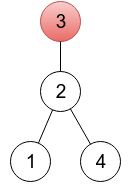A tree is an undirected connected graph without cycles.
Let's consider a rooted undirected tree with n vertices, numbered 1 through n. There are many ways to represent such a tree. One way is to create an array with n integers p1, p2, ..., pn, where pi denotes a parent of vertex i (here, for convenience a root is considered its own parent).
 For this rooted tree the array p is [2, 3, 3, 2].
For this rooted tree the array p is [2, 3, 3, 2].
Given a sequence p1, p2, ..., pn, one is able to restore a tree:
- There must be exactly one index r that pr = r. A vertex r is a root of the tree.
- For all other n - 1 vertices i, there is an edge between vertex i and vertex pi.
A sequence p1, p2, ..., pn is called valid if the described procedure generates some (any) rooted tree. For example, for n = 3 sequences(1,2,2), (2,3,1) and (2,1,3) are not valid.
You are given a sequence a1, a2, ..., an, not necessarily valid. Your task is to change the minimum number of elements, in order to get a valid sequence. Print the minimum number of changes and an example of a valid sequence after that number of changes. If there are many valid sequences achievable in the minimum number of changes, print any of them.
The first line of the input contains an integer n (2 ≤ n ≤ 200 000) — the number of vertices in the tree.
The second line contains n integers a1, a2, ..., an (1 ≤ ai ≤ n).
In the first line print the minimum number of elements to change, in order to get a valid sequence.
In the second line, print any valid sequence possible to get from (a1, a2, ..., an) in the minimum number of changes. If there are many such sequences, any of them will be accepted.
4 2 3 3 4
1 2 3 4 4
5 3 2 2 5 3
0 3 2 2 5 3
8 2 3 5 4 1 6 6 7
2 2 3 7 8 1 6 6 7
In the first sample, it's enough to change one element. In the provided output, a sequence represents a tree rooted in a vertex 4(because p4 = 4), which you can see on the left drawing below. One of other correct solutions would be a sequence 2 3 3 2, representing a tree rooted in vertex 3 (right drawing below). On both drawings, roots are painted red.

In the second sample, the given sequence is already valid.
题意:给定一个图,第i个点指向a[i],现让你改变最少的点的指向,使所有的点构成一棵生成树
思路:如果要改变最少的话,那么要修改的点只有孤立点和构成环的点,用并查集来找出这些点,并确定一个根节点(可以是孤立点,也可以是构成环的点)使得所有要修改的点直接指向这个根节点就行了
代码:
#include<stdio.h>
#include<string.h>
#include<algorithm>
using namespace std;
int fa[200005];
int find(int x)
{
if(x==fa[x])return x;
else return fa[x]=find(fa[x]);
}
int main()
{
int i,j,k,m,n;
int a[200005];
scanf("%d",&n);
for(int i=1;i<=n;i++)scanf("%d",&a[i]);
for(int i=1;i<=n;i++)fa[i]=i;
int flag=0;
int cnt=0;
int gen=-1;
for(int i=1;i<=n;i++)
if(a[i]==i)
{cnt++;
gen=i;
}
for(int i=1;i<=n;i++)
{
int xx=find(i);
int yy=find(a[i]);
if(a[i]==i)continue;
if(xx==yy)
{
a[i]=i;
cnt++;
}
else
fa[xx]=yy;
}
if(gen==-1)
for(int i=1;i<=n;i++)
if(a[i]==i)
{
gen=i;
cnt++;
break;
}
printf("%d\n",--cnt);
for(int i=1;i<=n;i++)
{
if(a[i]==i)a[i]=gen;
printf("%d ",a[i]);
}
return 0;
}暑假集训也好久了,刷的题到现在都没写过博客,刷的题也不多,空闲时间似乎全无所事事掉了……还是太懒了……感觉最近陷入了“看了题解也不会做,瞎做一通也过不了样例,过得了样例也a不了题,a的了题还下次是不会做”的怪圈,前途渺茫啊。

























 1725
1725

 被折叠的 条评论
为什么被折叠?
被折叠的 条评论
为什么被折叠?








